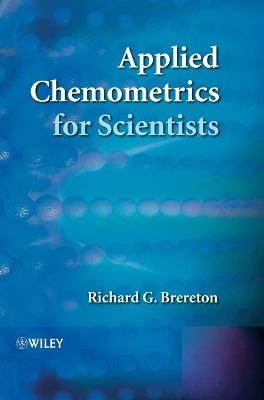
Applied Chemometrics for Scientists
John Wiley & Sons Inc (Verlag)
978-0-470-01686-2 (ISBN)
Richard G. Brereton, 1979-1983 : University of Cambridge, 1983 - : University of Bristol, current position Professor and Director of the Centre of Chemometrics, B.A., (Hons) 1976 (Natural Sciences, speciality chemistry; University of Cambridge), M.A., 1980 (University of Cambridge), Ph.D., 1981 (Thesis : Spectroscopic Studies of Bacteriochlorophyll a; supervisor : Prof. J.K.M.Sanders, FRS, Chemical Laboratory, University of Cambridge), MRSC, C.Chem., 1991 (Royal Society of Chemistry) Over 1250 citations in the literature, 60+ invited lectures, 30+ seminars given, 2 authored books, contributed to 9 edited works and has co-edited 3 books. Served as Associate Editor Chemometrics and Intelligent Laboratory Systems (Elsevier) for 5 years. Taught in undergraduate and graduate courses for over 20 years, written extensively in the application of Chemometrics.
Preface. 1 Introduction.
1.1 Development of Chemometrics.
1.2 Application Areas.
1.3 How to Use this Book.
1.4 Literature and Other Sources of Information.
References.
2 Experimental Design.
2.1 Why Design Experiments in Chemistry?
2.2 Degrees of Freedom and Sources of Error.
2.3 Analysis of Variance and Interpretation of Errors.
2.4 Matrices, Vectors and the Pseudoinverse.
2.5 Design Matrices.
2.6 Factorial Designs.
2.7 An Example of a Factorial Design.
2.8 Fractional Factorial Designs.
2.9 Plackett–Burman and Taguchi Designs.
2.10 The Application of a Plackett–Burman Design to the Screening of Factors Influencing a Chemical Reaction.
2.11 Central Composite Designs.
2.12 Mixture Designs.
2.13 A Four Component Mixture Design Used to Study Blending of Olive Oils.
2.14 Simplex Optimization.
2.15 Leverage and Confidence in Models.
2.16 Designs for Multivariate Calibration.
References.
3 Statistical Concepts.
3.1 Statistics for Chemists.
3.2 Errors.
3.3 Describing Data.
3.4 The Normal Distribution.
3.5 Is a Distribution Normal?
3.6 Hypothesis Tests.
3.7 Comparison of Means: the t-Test.
3.8 F-Test for Comparison of Variances.
3.9 Confidence in Linear Regression.
3.10 More about Confidence.
3.11 Consequences of Outliers and How to Deal with Them.
3.12 Detection of Outliers.
3.13 Shewhart Charts.
3.14 More about Control Charts.
References.
4 Sequential Methods.
4.1 Sequential Data.
4.2 Correlograms.
4.3 Linear Smoothing Functions and Filters.
4.4 Fourier Transforms.
4.5 Maximum Entropy and Bayesian Methods.
4.6 Fourier Filters.
4.7 Peakshapes in Chromatography and Spectroscopy.
4.8 Derivatives in Spectroscopy and Chromatography.
4.9 Wavelets.
References.
5 Pattern Recognition.
5.1 Introduction.
5.2 Principal Components Analysis.
5.3 Graphical Representation of Scores and Loadings.
5.4 Comparing Multivariate Patterns.
5.5 Preprocessing.
5.6 Unsupervised Pattern Recognition: Cluster Analysis.
5.7 Supervised Pattern Recognition.
5.8 Statistical Classification Techniques.
5.9 K Nearest Neighbour Method.
5.10 How Many Components Characterize a Dataset?
5.11 Multiway Pattern Recognition.
References.
6 Calibration.
6.1 Introduction.
6.2 Univariate Calibration.
6.3 Multivariate Calibration and the Spectroscopy of Mixtures.
6.4 Multiple Linear Regression.
6.5 Principal Components Regression.
6.6 Partial Least Squares.
6.7 How Good is the Calibration and What is the Most Appropriate Model?
6.8 Multiway Calibration.
References.
7 Coupled Chromatography.
7.1 Introduction.
7.2 Preparing the Data.
7.3 Chemical Composition of Sequential Data.
7.4 Univariate Purity Curves.
7.5 Similarity Based Methods.
7.6 Evolving and Window Factor Analysis.
7.7 Derivative Based Methods.
7.8 Deconvolution of Evolutionary Signals.
7.9 Noniterative Methods for Resolution.
7.10 Iterative Methods for Resolution.
8 Equilibria, Reactions and Process Analytics.
8.1 The Study of Equilibria using Spectroscopy.
8.2 Spectroscopic Monitoring of Reactions.
8.3 Kinetics and Multivariate Models for the Quantitative Study of Reactions
8.4 Developments in the Analysis of Reactions using On-line Spectroscopy.
8.5 The Process Analytical Technology Initiative.
References.
9 Improving Yields and Processes Using Experimental Designs.
9.1 Introduction.
9.2 Use of Statistical Designs for Improving the Performance of Synthetic Reactions.
9.3 Screening for Factors that Influence the Performance of a Reaction.
9.4 Optimizing the Process Variables.
9.5 Handling Mixture Variables using Simplex Designs.
9.6 More about Mixture Variables.
10 Biological and Medical Applications of Chemometrics.
10.1 Introduction.
10.2 Taxonomy.
10.3 Discrimination.
10.4 Mahalanobis Distance.
10.5 Bayesian Methods and Contingency Tables.
10.6 Support Vector Machines.
10.7 Discriminant Partial Least Squares.
10.8 Micro-organisms.
10.9 Medical Diagnosis using Spectroscopy.
10.10 Metabolomics using Coupled Chromatography and Nuclear Magnetic Resonance.
References.
11 Biological Macromolecules.
11.1 Introduction.
11.2 Sequence Alignment and Scoring Matches.
11.3 Sequence Similarity.
11.4 Tree Diagrams.
11.5 Phylogenetic Trees.
References.
12 Multivariate Image Analysis.
12.1 Introduction.
12.2 Scaling Images.
12.3 Filtering and Smoothing the Image.
12.4 Principal Components for the Enhancement of Images.
12.5 Regression of Images.
12.6 Alternating Least Squares as Employed in Image Analysis.
12.7 Multiway Methods In Image Analysis.
References.
13 Food.
13.1 Introduction.
13.2 How to Determine the Origin of a Food Product using Chromatography.
13.3 Near Infrared Spectroscopy.
13.4 Other Information.
13.5 Sensory Analysis: Linking Composition to Properties.
13.6 Varimax Rotation.
13.7 Calibrating Sensory Descriptors to Composition.
References.
Index.
| Erscheint lt. Verlag | 21.3.2007 |
|---|---|
| Verlagsort | New York |
| Sprache | englisch |
| Maße | 175 x 252 mm |
| Gewicht | 907 g |
| Themenwelt | Mathematik / Informatik ► Mathematik ► Angewandte Mathematik |
| Naturwissenschaften ► Chemie | |
| ISBN-10 | 0-470-01686-8 / 0470016868 |
| ISBN-13 | 978-0-470-01686-2 / 9780470016862 |
| Zustand | Neuware |
| Haben Sie eine Frage zum Produkt? |
aus dem Bereich


